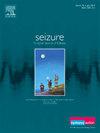EEG and semiology in the elderly: A systematic review
IF 2.7
3区 医学
Q2 CLINICAL NEUROLOGY
引用次数: 0
Abstract
Introduction
The prevalence and incidence of epileptic seizures and epilepsy increases among the elderly. Epileptic seizures in older people remain often unreported and undiagnosed, contributing to incorrect or delayed treatment. The goal of our review paper is to increase awareness of seizures in the elderly, to improve the diagnostic process in this growing population.
Methods
We present a systematic review of the literature on EEG findings and seizure semiology among the elderly according to the PRISMA statement. One hundred and two original studies were included and findings were divided in four groups: EEG among elderly without seizures, EEG among elderly with seizures or epilepsy, semiology, and status epilepticus.
Conclusions
EEG abnormalities are found in approximately half of the geriatric population referred to routine EEG. Slowing (both focal and diffuse) is the most common finding among seniors with and without seizures. Interictal epileptiform discharges (IEDs) are likewise seen among healthy seniors, which reduces their specificity as biomarker for epilepsy. Focal onset seizures prevail among the aged. Generalized seizures are uncommon, starting usually earlier in life but exacerbating in later years. Motor phenomena are less frequently seen than among younger individuals. Seizures are mainly characterized by impairment of awareness, disturbed cognition and confusion, both ictally and postictally. Unresponsiveness may occur during non-epileptic events too, which further challenges seizure recognition. Epilepsy and dementia are bi-directionally related: dementia carries an increased risk of developing epilepsy and vice versa. Up to 45 % of the aged with new onset seizures present with status epilepticus (SE). SE among the elderly is more often focal motor; non-convulsive status epilepticus (NSCE) constitutes 10–25 %.
老年人的脑电图和半身像:系统回顾。
引言 老年人癫痫发作和癫痫的流行率和发病率都在增加。老年人癫痫发作常常得不到报告和诊断,导致治疗不正确或延误。我们的综述论文旨在提高人们对老年人癫痫发作的认识,从而改善这一日益增长的人群的诊断过程。方法 我们根据 PRISMA 声明对有关老年人脑电图结果和癫痫发作半身像的文献进行了系统性综述。我们根据 PRISMA 声明,对有关老年人脑电图结果和癫痫发作半身像的文献进行了系统回顾:结论 在转诊至常规脑电图检查的老年人群中,约有半数发现脑电图异常。迟钝(局灶性和弥漫性)是有癫痫发作和无癫痫发作的老年人中最常见的发现。发作间期癫痫样放电(IEDs)同样见于健康的老年人,这降低了其作为癫痫生物标志物的特异性。老年人多为局灶性发作。全身性癫痫发作并不常见,通常在生命早期开始,但在晚年会加剧。运动现象比年轻人少见。癫痫发作的主要特征是意识障碍、认知紊乱和意识模糊,包括发作前和发作后。在非癫痫事件中也可能出现反应迟钝,这对识别癫痫发作提出了进一步挑战。癫痫和痴呆是双向相关的:痴呆会增加患癫痫的风险,反之亦然。在新近出现癫痫发作的老年人中,多达 45% 的人表现为癫痫状态(SE)。老年人的癫痫状态多为局灶性运动性;非惊厥性癫痫状态(NSCE)占 10-25%。
本文章由计算机程序翻译,如有差异,请以英文原文为准。
求助全文
约1分钟内获得全文
求助全文
来源期刊

Seizure-European Journal of Epilepsy
医学-临床神经学
CiteScore
5.60
自引率
6.70%
发文量
231
审稿时长
34 days
期刊介绍:
Seizure - European Journal of Epilepsy is an international journal owned by Epilepsy Action (the largest member led epilepsy organisation in the UK). It provides a forum for papers on all topics related to epilepsy and seizure disorders.
 求助内容:
求助内容: 应助结果提醒方式:
应助结果提醒方式:


